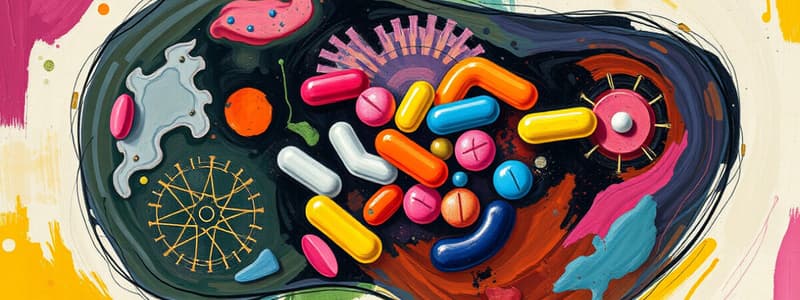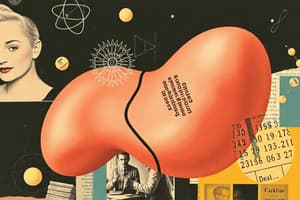Podcast
Questions and Answers
What is the mechanism of action of statins?
What is the mechanism of action of statins?
Decrease LDL, Inhibit MHG CoA reductase, Decrease hepatic synthesis of cholesterol.
What are the secondary effects of statins?
What are the secondary effects of statins?
- Increase LDL
- Increase HDL (correct)
- Decrease triglycerides (correct)
- Inhibit VLDL synthesis
What are the pleiotropic effects of statins?
What are the pleiotropic effects of statins?
Decrease endothelial dysfunction, Increase plaque stability, Decrease platelet activation/agglutination, Decrease vascular inflammation.
Primary indications for statin use include cholesterol levels greater than ______ mg/dL.
Primary indications for statin use include cholesterol levels greater than ______ mg/dL.
Which condition is a secondary indication for statin use?
Which condition is a secondary indication for statin use?
What are common ADRs associated with statins?
What are common ADRs associated with statins?
Which of the following is a risk factor for statin-induced myopathy?
Which of the following is a risk factor for statin-induced myopathy?
Name a statin that interacts with 3A4 inhibitors.
Name a statin that interacts with 3A4 inhibitors.
Which statin interacts with 2C9?
Which statin interacts with 2C9?
Which of the following statins undergoes minimal to no CYP metabolism?
Which of the following statins undergoes minimal to no CYP metabolism?
Flashcards are hidden until you start studying
Study Notes
Statins Mechanism of Action (MOA)
- Statins effectively lower LDL levels in the blood.
- They inhibit HMG-CoA reductase, the enzyme crucial for converting HMG-CoA to mevalonic acid.
- Reduced hepatic cholesterol synthesis prompts the liver to increase LDL receptor expression, facilitating LDL uptake from circulation.
- This results in a dual mechanism for LDL level reduction.
Secondary Effects of Statins
- Statins raise HDL levels by stimulating the maturation of HDL through hydrolysis.
- They lower triglyceride levels by decreasing hepatic synthesis of VLDL and enhancing the return of VLDL/IDL remnants to the liver.
Pleiotropic Effects of Statins
- Improve endothelial function, contributing to vascular health.
- Stabilize atherosclerotic plaques, reducing the risk of rupture.
- Decrease platelet activation and aggregation, aiding in thrombus prevention.
- Reduce vascular inflammation, which is beneficial for cardiovascular health.
Primary Indications for Statin Use
- Recommended for individuals with cholesterol levels exceeding 190 mg/dL.
- Indicated for patients aged 40-75 with diabetes and cholesterol levels between 70-189 mg/dL.
- Appropriate for individuals aged 40-75 with an ASCVD 10-year risk greater than 7.5% and cholesterol between 70-189 mg/dL.
Secondary Indications for Statin Use
- Prescribed for clinically evident ASCVD, including conditions like angina, myocardial infarction (MI), stroke, transient ischemic attack (TIA), and peripheral artery disease (PAD).
- Statins have proven efficacy in preventing first strokes or MIs and lowering the risk of subsequent events.
Adverse Drug Reactions (ADRs) of Statins
- Rare occurrences of hepatic dysfunction marked by elevated ALT and AST levels.
- Common side effects include headache and constipation.
- Statins are classified as pregnancy category X due to potential harm.
- Risk of new-onset diabetes is a concern with statin therapy.
- Possible muscle-related issues, including myalgia, myopathy, and severe rhabdomyolysis.
Risk Factors for Statin-Induced Myopathy
- Increased risk in individuals over 80 years of age.
- Higher incidence in women compared to men.
- Pre-existing severe chronic kidney disease (CKD) elevates risk.
- Liver dysfunction can predispose patients to myopathy.
- Alcohol abuse and certain interacting medications also heighten risk.
- High consumption of grapefruit juice can lead to myopathy.
Interaction with 3A4 Inhibitors
- Statins such as atorvastatin, simvastatin, and lovastatin are metabolized by CYP3A4 enzymes and can be significantly affected by 3A4 inhibitors.
Interaction with 2C9
- Fluvastatin is primarily affected by interactions with CYP2C9 inhibitors.
Minimal to No CYP Metabolism
- Pravastatin and rosuvastatin exhibit minimal to no dependence on CYP metabolism, making them less susceptible to drug interactions.
Studying That Suits You
Use AI to generate personalized quizzes and flashcards to suit your learning preferences.



